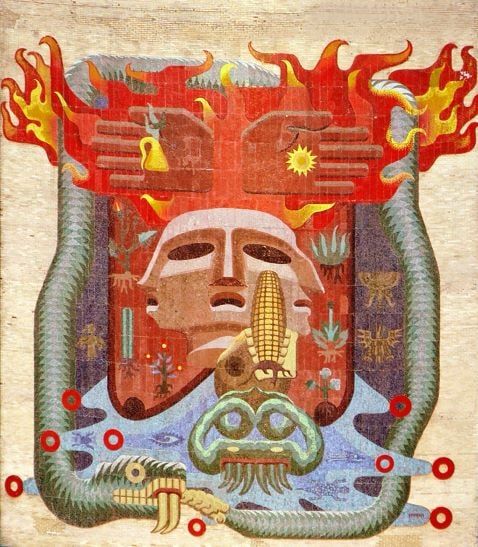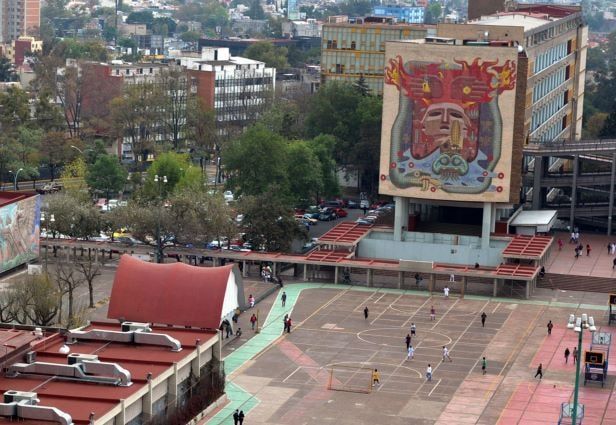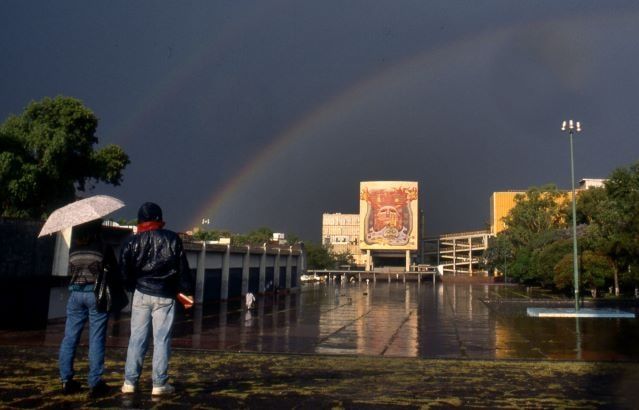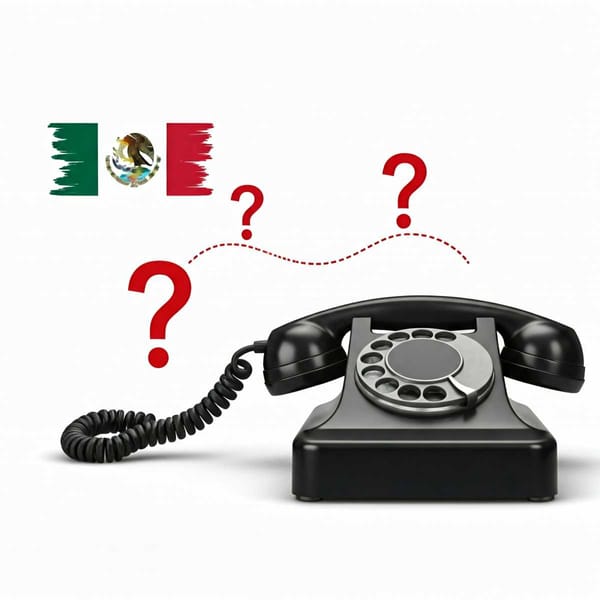Mural "Life, Death, Mestizaje, and the Four Elements" by Francisco Eppens
The mural titled "Life, Death, Mestizaje, and the Four Elements" was painted by Francisco Eppens Helguera and is considered to be one of the most famous paintings on the main campus of University City.

Life, Death, Mestizaje, and the Four Elements by Francisco Eppens Helguera is one of the best-known murals on the central campus of University City. It is on the west facade of the School of Medicine. Helguera himself thought it was the most important piece of his career.
"I would also consider the mural of the School of Medicine the most important work of Francisco Eppens," considered Mireida Velázquez Torres, director of the National Museum of San Carlos, and added: "Not only its dimensions make us think of this great project, but also the place where it is located, that you can observe it from many meters away, in one of the most important buildings of the central campus. The visual shot allows you to compare it or put it in dialogue with the modern architecture of the campus, which for me is an honor that Francisco Eppens was given to carry out.
Julieta Ortiz Gaitán, an expert at the Institute for Aesthetic Research, agrees with this point since Eppens's participation in the original plan for the University City was a highlight of his career and proof of his talent as an artist:
"If we compare it to the other murals (he did previously), they were more inconsequential in a certain way. Being in the University City and being part of such an important project—it brought together more than 50 architects—in which plastic integration was very relevant. To have done a mural in these conditions and surroundings was significant for Eppens. Sincerely, all the mural work in University City is the culmination of the combative muralism of the 20s of the last century that advanced and came to this.
"There is an important valuation in University City of other muralists, that is to say, it gives way to this second generation. At that time, Jose Clemente Orozco had already passed away, but we not only have the presence of Diego Rivera and David Alfaro Siqueiros in two very important works in his career but the work of other muralists, such as Jose Chavez Morado or Eppens himself, for example, is given a boost, "Mireida Velazquez stressed.
However, the former coordinator of the Curatorial Studies Program in the Master's Degree in Art History at UNAM said, "We are always thinking about this idea of a first and second generation of muralists. However, Francisco Eppens began his artistic career doing murals, and not everyone has that in mind. He did murals from very early in the 1930s. The difference is that he started working in private buildings. These private commissions did not have the characteristic of being seen by a wider public. "

Mural "Life, Death, Mestizaje, and the Four Elements" by Francisco Eppens
Like La superación del hombre por medio de la cultura ("The Overcoming of Man through Culture"), which adorns the exterior wall of the José J. Rojo Auditorium of the School of Dentistry, in La vida, la muerte, el mestizaje y los cuatro elementos ("Life, Death, Mestizaje and the Four Elements"), it is possible to observe how the pre-Hispanic cosmovision influenced Eppens' work and how embracing this mestizo heritage was indispensable for the future development of the country.
"It is an important fact that it is in this great esplanade that nothing obstructs the view. It is a privileged place. "It was a great achievement of Francisco Eppens; he did very important work; although sometimes he is not recognized much, he was an artist very dedicated to his work and his conviction that art and culture are the way to obtain the spiritual, material, and cultural progress that drives a country to raise its standard of living," said Ortiz.
Other elements that make Eppens' mural stand out, reflected in the winner of the Sor Juana Inés de la Cruz Award (2017), are the pilotis on which the building rests: "They are classical architectural elements, very representative of the functionalist architecture that governed this ensemble, inspired by the great architects of modernism. They are columns that lift the buildings, giving them a lot of light and greater visibility. We find them all over Ciudad Universitaria".
The piece, like other murals on the central campus, was made with a glass mosaic technique. Artists and architects chose this method because it can stand up to the effects of weather and time while keeping its bright colors.
"The truth is that he is experimenting for the first time with a mosaic. It is a technique that, given the characteristics of the buildings on the university campus, had to be put in place so that the murals could survive in optimal conditions. "This mural of Life, Death, Mestizaje, and the Four Elements is finally at the mercy of all the natural elements, and in another technique, it would have suffered a lot, it would have been in constant restoration," argued Mireida Velázquez.
Eppens decided, unlike other artists, to work with a Mexican company—Mosaicos Venecianos de México, S.A.—to provide the mosaics for his work. Since there wasn't the color Francisco needed in this company—it was very new and didn't have the full stock of colors, specifically the green that Eppens required—they had to use plates and fragment them to get the green needed for the proposal.
"The space given to Francisco Eppens is not only one of the most important on the campus, but it is also a complex space because of the curvature of the building. There he is faced with the technical solution of, for example, making small pre-cast panels or small slabs that were pre-cast and attached to the building by sectioned parts, so that in the end the mural could come off. "It is not a transportable mural as such, but if necessary, it could be detached to be placed in another place," added the director of the National Museum of San Carlos.

Symbols of the mural Life, Death, Mestizaje, and The Four Elements
Life, death, mestizaje, and the four elements have a concentric composition, which means that most of their components are at the center of the design. These are framed by a snake biting its tail, which, according to Julieta Ortiz, "is related to wisdom, strength, and knowledge. All these are symbols of ancient cultures, not only from the Valley of Mexico but also from Egypt and Syria. Its poison is also related to the medicines that cure some of humanity's ailments. Everything is linked to the Rod of Aesculapius, which is the symbol of medicine; it is a staff with a snake around it".
Similarly, Mireida Velázquez indicated, that the presence of this symbol "alludes to life and death; it will give us the idea of eternity, of that continuous cycle that is life itself. The idea of the scene framed by a snake seems to me a beautiful solution, which eats its tail to show the idea of continuity, of the cycles that go on and on and on. "
In the center of the composition, it is possible to observe three faces that merge to represent modern Mexico. As Velázquez explains, "They refer especially to the racial mix that gave birth to the contemporary Mexican. We are talking about the indigenous mother on one side, the Spanish father on the other, and, in the center, this mestizo son, which is the Mexican nation".
Above the serpent, "in the water, we find Tlaloc, who with his two eyes is looking at the inhabitants of the water-an axolotl, a water flea, fish, and other animals. At the ends are some very beautiful cobalt blues, very beautiful that represents the air along with butterflies and different birds, "said Julieta Ortiz.

Another thing related to water is the beginning of life, "Mireida Velázquez indicated," that is where it originates; it is the lower part of the mural; then there is the air and the earth in the middle with Coatlicue, who presents a big corn cob on her chest, very close to the center of her figure. "Corn is basic to the peoples of America; even ancient mythology says that American man was formed from corn."
"At the top of the composition is a breast, which may allude to fertility through this idea of motherhood. They are joined by hands carrying a pollen grain on one side and a germinated seed on the other. "The whole set will refer us to life, to continuous cycles, to fertility, and to the power of creating a whole new race from this mixture," Velázquez added.
Ortiz is the author of the publication Imágenes del deseo. Arte y publicidad en la prensa ilustrada mexicana ("Images of Desire. Art and Advertising in the Mexican Illustrated Press") mentioned that in the upper section of the mural "there is a very beautiful element that Eppens repeats: a head in flames. Fire is a Promethean idea because it is the fire of the gods. It is also seen in La superación del hombre por medio de la cultura, a man rooted to the earth but with his head on fire. According to my interpretation, it is this "continuous movement, this thirst, the spirit of moving forward, always going forward by the restlessness of knowledge."
Currently, the mural La vida, la muerte, el mestizaje y los cuatro elementos by Francisco Eppens is in the process of restoration, a sign of the importance of the mural legacy for the National University. Mireida Velázquez assures: "It is fundamental that the university provides resources for such important work, and it is a moment in which these murals deserve it. It is very special to celebrate by restoring them."
Julieta Ortiz emphasized that "the importance of all this great work of architecture, sculpture, and painting is that it is full of life. That is what the artists wanted: that their works were not in museums but open spaces, available to anyone. Anyone who comes here can enjoy all these murals. This is the message that these muralists wanted to leave: the university as a path to a better future.




